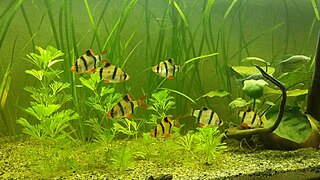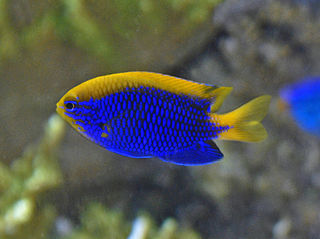
The tiger barb or Sumatra barb, is a species of tropical cyprinid fish. The natural geographic range reportedly extends throughout the Malay Peninsula, Sumatra and Borneo in Indonesia, with unsubstantiated sightings reported in Cambodia. Tiger barbs are also found in many other parts of Asia, and with little reliable collection data over long periods of time, definite conclusions about their natural geographic range versus established introductions are difficult. Tiger barbs may sometimes be confused with Puntigrus anchisporus, Puntigrus navjotsodhii, or Puntigrus partipentazona, which are similar in appearance, the only differences being the slightly different stripe pattern and the number of scales these fish have.

The royal gramma, also known as the fairy basslet, is a species of fish in the family Grammatidae native to reef environments of the tropical western Atlantic Ocean. They are commonly kept in aquariums.

Stegastes is a genus of ray-finned fish in the family Pomacentridae. Members of this genus are marine coastal fishes except for S. otophorus, which also occurs in brackish water. These fish are known by the names of damselfish, gregory and major. They are small tropical fish associated with coral and rocky reefs in the Atlantic, Indian and Pacific Oceans. They are sometimes found in the aquarium trade where they are an easy-to-keep fish, but they do not mix well with other fish of their own or other species because of their territorial habits and aggressiveness.

The bicolor angelfish is a marine species of fish, easily recognizable by its yellow tail, yellow front half of their body, and blue rear with blue patterns above and around the eye. Other names of this angelfish include: Pacific rock beauty, oriole angelfish, oriole dwarf angel, blue and gold angel, and two-colored angel. The life expectancy in the wild varies greatly, depending on location, and ranges between 5 and 13 years. These fish tend to grow to a maximum of 6 inches in length. The larval stages lasts approximately 32 days.

Chrysiptera is a genus of damselfish in the family Pomacentridae.

Taraporewala Aquarium or Taraporevala Aquarium is India's oldest aquarium and one of Mumbai's main attractions. It hosts marine and freshwater fish. The aquarium is located on Marine Drive.

Chrysiptera cyanea is a species of damselfish found in the wide Indo-West Pacific but not known in the Red Sea. A few individuals were observed in the Mediterranean Sea in 2013 off Slovenia, a likely aquarium release.

Chrysiptera taupou, known commonly as the southseas devil, southseas demoiselle, and Fiji damsel, is a species of damselfish. It is native to the western Pacific Ocean from the Coral Sea to Samoa.

Chrysiptera talboti, known commonly as Talbot's damselfish and Talbot's demoiselle, is a species of damselfish. It is a marine fish from the eastern Indian Ocean and western Pacific.

Chrysiptera hemicyanea, known commonly as the azure damselfish, azure demoiselle, half-blue demoiselle, and yellow-dipped damsel, is a species of damselfish.
Chrysiptera galba, commonly known as the canary demoiselle, is a species of damselfish. It is native to the western Pacific Ocean. It reaches 7 centimeters in length. The male guards and tends the eggs.

Chrysiptera starcki, commonly known as Starck's demoiselle, is a species of damselfish in the family Pomacentridae. It is native to the western Pacific Ocean, where it has been reported from the Ryukyu Islands and Taiwan to Australia, New Caledonia, and Tonga. It was originally described in 1973 as Abudefduf starcki.

Neoglyphidodon melas, also known as the bowtie damselfish, black damsel, bluefin or royal damsel, is a species of damselfish found in the Indo-West Pacific. It often makes its way into the aquarium trade. It grows to a size of 18 cm (7.1 in) in length.

The yellowtail damselfish is a species of damselfish native to tropical areas such as the Caribbean coast of Panama. Damselfish are abundant in coral reef environments. The International Union for Conservation of Nature lists this fish as being of “least concern”. The species is exploited on a minor scale, for fisheries and the aquarium trade. It may be threatened by the invasive lionfish.

Stegastes planifrons is a damselfish from the Western Atlantic. It occasionally makes its way into the aquarium trade.

Elacatinus puncticulatus is a species of goby from the eastern central Pacific Ocean, where it is found on reefs from the Gulf of California to Ecuador. This species occurs at depths ranging from 1 to 21m, and usually in association with the sea urchin Eucidaris thouarsii. The size of the goby varies depending on sex, with females being typically smaller than males, and their geographical location as well as their role as a cleaner goby also has impacts on their morphology. Due to their bright coloration and lack of aggression, the species is commonly found in the aquarium trade.

Chrysiptera rollandi, commonly known as Rolland's demoiselle, is a species of damselfish in the family Pomacentridae.

The violet goby is a species of goby native to marine, fresh and brackish waters near the Atlantic coast of North and South America from South Carolina in the United States of America, to northern Brazil. It prefers bays, estuaries and river mouths with muddy substrates. It is often marketed as the dragon goby or dragon fish.

Neoglyphidodon oxyodon, the neon velvet damselfish is a species of damselfish in the family Pomacentridae. It is found in the Pacific Ocean. They are found in the aquarium hobby.



















